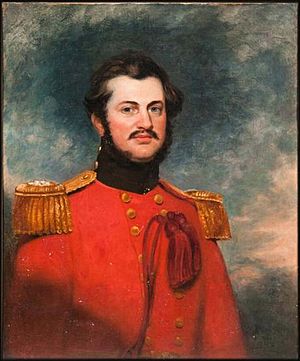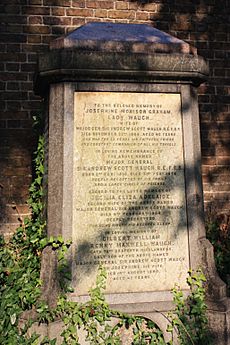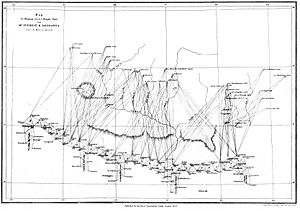Andrew Scott Waugh facts for kids
Major General Sir Andrew Scott Waugh (born February 3, 1810 – died February 21, 1878) was a British army officer. He became the Surveyor General of India. He worked on the Great Trigonometrical Survey, a huge project to map India. Waugh took over from Sir George Everest in 1843. He is famous for naming the world's highest peak, Mount Everest.
Early Life and Training
Andrew Scott Waugh was the first son of General Gilbert Waugh. His father worked in Madras (now Chennai). Andrew studied in Edinburgh, Scotland. In 1827, he joined the Addiscombe Military Seminary. He became an officer with the Bengal Engineers that same year.
He trained further in England. In May 1829, he arrived in India. He helped set up a factory in Kashipur. In 1832, he joined the Great Trigonometrical Survey. He worked under George Everest. Waugh surveyed many parts of central India. Everest praised Waugh's math skills and how he used instruments.
Becoming Surveyor General
In 1843, George Everest retired. He suggested that Waugh was the best person to replace him. So, Waugh became the new Surveyor General. He then focused on surveying the Himalayas. This survey covered a huge area, about 1690 miles long.
The Himalayan mountains were very tall. The weather there was also very unpredictable. This made surveying very difficult. It was hard to get clear measurements. In those days, there were no electronic computers. So, a team of people had to do all the calculations. This took many months.
In 1852, a team leader named Radhanath Sikdar made an exciting discovery. He told Waugh that "Peak XV" was the highest point in the region. It was likely the highest in the world. Sikdar and Waugh checked their numbers many times. They wanted to be absolutely sure. They sent a message to the Royal Geographical Society. They confirmed that Kangchenjunga was not the world's highest peak.
To be extra careful, Waugh waited until 1856 to announce the discovery. At that time, he also suggested a name for the peak. He wanted to name it Mount Everest. This was to honor his old boss, George Everest. Waugh first thought of "Mont Everest" but changed it.
Everest usually used local names for mountains. Waugh also tried to do this. But for Peak XV, there were many local names. It was hard to find one name everyone used. So, the name "Mount Everest" was officially chosen. George Everest himself didn't want the mountain named after him. But the Royal Geographical Society adopted the name anyway.
The height of Mount Everest was first calculated as 29,000 ft (8,839.2 m). But Waugh announced it as 29,002 ft (8,839.8 m). He did this so people wouldn't think it was just a guess. This led to a funny saying: Waugh was "the first person to put two feet on top of Mount Everest"!
Waugh also noticed some errors in his measurements. These errors seemed to be caused by the mountains pulling on his tools. He asked a mathematician, Archdeacon John Henry Pratt, for help. Pratt studied the problem. He came up with the idea of isostasy. This is a theory about how the Earth's crust balances itself.
After identifying Mount Everest, Waugh received many awards. In 1857, he got the Patron's Medal from the Royal Geographical Society. The next year, he became a Fellow of the Royal Society. In 1861, he became a Major General. Henry Edward Landor Thuillier took over as Surveyor General.
Waugh also wrote a book called Instructions for Topographical Surveying in 1861. His survey findings were published in many reports.
Later Life
Sir Andrew Scott Waugh passed away in 1878. He is buried in Brompton Cemetery in west London.
Personal Life
His first wife was Josephine. She died in 1866. His second wife was Cecilia Eliza Adelaide. She passed away in 1884.





